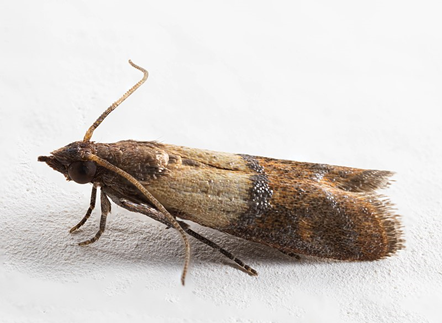


Indian meal moth is a worldwide pest that can affect everything from individual pantries to expansive stored grain and product facilities. Learn more about this pest and the damage it can cause in this article.
The Indian meal moth is a prevalent pest in the stored food industry. This small, half-inch moth has a drab appearance with a distinct coppery sheen on its wings. However, the larvae pose the greatest threat, as they are the feeding stage and cause significant damage, which is a major concern for pest management professionals and food quality managers.
Indian meal moth larvae are about the same size as adults, though this can vary by instar. They are off-white with brown heads and are relatively mobile for caterpillars. During pupation, they can move far from their food source, complicating eradication efforts. They often spin silk cocoons around their pupae before emerging as adults.

Indian meal moth adult. Photo: Michel Vuijlsteke
While Indian meal moths are the most common pests of their family, several closely related moths exist with similar behavior and appearance to Indian meal moth (P. interpunctella). Common similar stored product moths are Mediterranean flour moth (E. kuehniella), raisin moth (C. figulilella), almond/tropical warehouse moth (C. cautella), and tobacco moth (E. elutella). Because these species are closely related, pheromone monitoring and management are effective for all these stored product moths. However, identifying the specific moth species is still important to ensure the damage is not caused by a different pest.
Like most insects, the development time of Indian meal moths is determined by temperature. Therefore, in hotter climates and warmer parts of the year, facility managers are more likely to see higher numbers of meal moth, due to faster generation times. While they may enter a state of dormancy in cold winter conditions, the pest can persist year-round in facilities with artificially elevated temperatures.
Larval Indian meal moths are voracious feeders that infest and consume a wide variety of stored food products. They can be found in facilities storing nuts, coffee, grains, dog food, maize, birdseed, dried fruit, and more. The primary concerns with Indian meal moth damage are the food they consume and the silk they leave behind. This sticky webbing accumulates frass, eggshells, and other waste products over time, making the product unappealing to customers. Additionally, the waste can serve as a vector for other contaminants, potentially spoiling the product for the final user.
Once an infestation of Indian meal moths is discovered, it can be extremely difficult to eliminate due to their mobility and fecundity. Although they are somewhat attracted to light, the best way to manage and monitor these moths is by using pheromone products.
The most effective way to look out for and cut down on Indian meal moth numbers in your facility is by using a proper IPM strategy including pheromone products. When female moths wish to seek out a mate, they produce a sex pheromone, a unique chemical signal that attracts males of the same species. Pheromone monitoring products perfectly replicate this signal, attracting male moths just as a genuine female moth would.
Historically, the Indian meal moth pheromone has primarily been used for monitoring purposes. With pheromone traps and lures, the pheromone lure will emit a concentrated signal to males, attracting them to a sticky trap where pest management professionals can later count them to inform on pest prevalence, locality, timing, and many more important data points. Suterra offers pheromone traps and lures for Indian meal moth and other stored product moths here.
These pheromones are now being adopted and used in large commercial settings not solely to monitor the pest but to reduce pest pressure overall, via a process called mating disruption. Mating disruption works by dispersing a large amounts of the female’s sex pheromone into the facility’s air, rendering males unable to find females and, therefore, unable to reproduce during their short lifespan. The ambient pheromone is non-toxic and leaves no residue, making it safe to use in organic facilities. So much so that the active substances are considered exempt from the setting of a tolerance by the EPA.
Suterra’s Puffer® IMM is unique in the stored product pheromone control category because, unlike hanging dispensers, the Puffer® is an aerosol emitter. "25 years ago, Suterra came out with our Puffer® technology. We were the first to bring aerosol technology to the agricultural pest control space, and now we get to bring it from those agricultural fields into stored products facilities." Says Sarah Chapman, Product Portfolio Manager with Suterra. Unlike dispensers, the Puffer will always emit a consistent amount of pheromone that is not dependent on climate conditions. It lasts 6 months and, due to the broad area in a warehouse that a single Puffer can cover, takes very little time to install, making it cost- and labor-efficient compared to other pheromone products. Increasing deployment time by roughly 80% and potentially decreasing unscheduled fogging occurrences.
If you have questions about Indian meal moth, stored product pests, or mating disruption, the experts at Suterra are happy to help. Contact your local sales representative or send us a message on our website here.